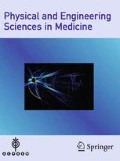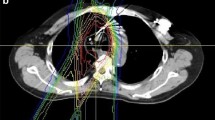Abstract
The implementation of stereotactic body radiation therapy (SBRT) and stereotactic radiosurgery (SRS) has greatly increased due to its convenience and advantages from perspectives ranging from radiobiology to radio physics. Because SBRT/SRS delivers high doses in few fractions, precise dose delivery to target volumes and sufficient sparing of adjacent organs at risk (OARs) are required. Achieving these conflicting objectives is challenging for all patients receiving SBRT/SRS and may be particularly challenging when SBRT/SRS is adopted for treating patients with cardiac implantable electronic devices (CIEDs) because cumulative doses in CIEDs must be limited. Published research considering the different aspects of stereotactic treatment in patients with CIEDs was reviewed to summarise their findings in the following sections: (I) conventional linear accelerator (linac)-based SBRT and SRS; (II) CyberKnife, Gamma-Knife, VERO and helical tomotherapy SBRT and SRS; and (III) proton therapy. A total of 65 patients who had CIEDs and underwent SRS, SBRT, or SABR treatments were identified in the reviewed studies. The functionality of the CIEDs was assessed for 58 patients. Of those, CIED malfunctions (such as data loss, mode change, and inappropriate shock) were reported in four patients (6.89%). This review highlights the available sparse information in the literature by posing questions for future research.
Similar content being viewed by others
References
Brown JM, Brenner DJ, Carlson DJ (2013) Dose escalation, not “New Biology”, can account for the efficacy of stereotactic body radiation therapy with non-small cell lung cancer. Int J Radiat Oncol 85:1159–1160. https://doi.org/10.1016/j.ijrobp.2012.11.003
Taylor ML, Kron T, Franich RD (2011) A contemporary review of stereotactic radiotherapy: inherent dosimetric complexities and the potential for detriment. Acta Oncol (Madr) 50:483–508. https://doi.org/10.3109/0284186X.2010.551665
Marbach JR, Sontag MR, Van Dyk J, Wolbarst AB (1994) Management of radiation oncology patients with implanted cardiac pacemakers: report of AAPM Task Group No. 34. Med Phys 21:85–90. https://doi.org/10.1118/1.597259
Studenski MT, Xiao Y, Harrison AS (2012) Measuring pacemaker dose: a clinical perspective. Med Dosim 37:170–174. https://doi.org/10.1016/j.meddos.2011.06.007
Ferrara T, Baiotto B, Malinverni G et al (2010) Irradiation of pacemakers and cardio-defibrillators in patients submitted to radiotherapy: a clinical experience. Tumori J 96:76–83. https://doi.org/10.1177/030089161009600113
Gelblum DY, Amols H (2009) Implanted cardiac defibrillator care in radiation oncology patient population. Int J Radiat Oncol 73:1525–1531. https://doi.org/10.1016/j.ijrobp.2008.06.1903
Zaremba T, Jakobsen AR, Thogersen AM et al (2014) The effect of radiotherapy beam energy on modern cardiac devices: an in vitro study. Europace 16:612–616. https://doi.org/10.1093/europace/eut249
Zecchin M, Morea G, Severgnini M et al (2016) Malfunction of cardiac devices after radiotherapy without direct exposure to ionizing radiation: mechanisms and experimental data. Europace 18:288–293. https://doi.org/10.1093/europace/euv250
Hashimoto T, Isobe T, Hashii H et al (2012) Influence of secondary neutrons induced by proton radiotherapy for cancer patients with implantable cardioverter defibrillators. Radiat Oncol 7:10. https://doi.org/10.1186/1748-717X-7-10
Mouton J, Haug R, Bridier A et al (2002) Influence of high-energy photon beam irradiation on pacemaker operation. Phys Med Biol 47:2879–2893
Elders J, Kunze-Busch M, Jan Smeenk R, Smeets JLRM (2013) High incidence of implantable cardioverter defibrillator malfunctions during radiation therapy: neutrons as a probable cause of soft errors. EP Eur 15:60–65. https://doi.org/10.1093/europace/eus197
Zaremba T, Jakobsen AR, Søgaard M et al (2015) Risk of device malfunction in cancer patients with implantable cardiac device undergoing radiotherapy: a population-based cohort study. Pacing Clin Electrophysiol 38:343–356. https://doi.org/10.1111/pace.12572
Riley B, Garcia J, Guerrero T (2004) The utilization of a 3-dimensional noncoplanar treatment plan to avoid pacemaker complications. Med Dosim 29:92–96. https://doi.org/10.1016/j.meddos.2004.03.013
Hurkmans CW, Knegjens JL, Oei BS et al (2012) Management of radiation oncology patients with a pacemaker or ICD: a new comprehensive practical guideline in The Netherlands. Radiat Oncol 7:198. https://doi.org/10.1186/1748-717X-7-198
Gauter-Fleckenstein B, Israel CW, Dorenkamp M et al (2015) DEGRO/DGK guideline for radiotherapy in patients with cardiac implantable electronic devices. Strahlenther und Onkol 191:393–404. https://doi.org/10.1007/s00066-015-0817-3
Salerno F, Gomellini S, Caruso C et al (2016) Management of radiation therapy patients with cardiac defibrillator or pacemaker. Radiol Med 121:515–520. https://doi.org/10.1007/s11547-015-0616-z
Zecchin M, Severgnini M, Fiorentino A et al (2018) Management of patients with cardiac implantable electronic devices (CIED) undergoing radiotherapy. Int J Cardiol 255:175–183. https://doi.org/10.1016/j.ijcard.2017.12.061
Zaremba T, Jakobsen AR, Søgaard M et al (2016) Radiotherapy in patients with pacemakers and implantable cardioverter defibrillators: a literature review. Europace 18:479–491. https://doi.org/10.1093/europace/euv135
Hudson F, Coulshed D, D’Souza E, Baker C (2010) Effect of radiation therapy on the latest generation of pacemakers and implantable cardioverter defibrillators: a systematic review. J Med Imaging Radiat Oncol 54:53–61. https://doi.org/10.1111/j.1754-9485.2010.02138.x
Berlach DM, Beliveau-Nadeau D, Roberge D (2011) Robotic radiosurgery and the “fingers of death”. Cureus. https://doi.org/10.7759/cureus.33
Kry SF, Bednarz B, Howell RM et al (2017) AAPM TG 158: measurement and calculation of doses outside the treated volume from external-beam radiation therapy. Med Phys 44:e391–e429. https://doi.org/10.1002/mp.12462
Xiao Y, Kry SF, Popple R et al (2015) Flattening filter-free accelerators: a report from the AAPM Therapy Emerging Technology Assessment Work Group. J Appl Clin Med Phys 16:12–29. https://doi.org/10.1120/jacmp.v16i3.5219
Rieber J, Tonndorf-Martini E, Schramm O et al (2016) Establishing stereotactic body radiotherapy with flattening filter free techniques in the treatment of pulmonary lesions—initial experiences from a single institution. Radiat Oncol 11:80. https://doi.org/10.1186/s13014-016-0648-0
Aslian H, Severgnini M, Bregant P, Longo F (2018) Imaging dose to cardiovascular implantable electronic devices (CIEDs) from the Elekta synergy X-ray cone beam CT system: a dosimetric study using gafchromic film XR-QA2. Australas Phys Eng Sci Med 41:268. https://doi.org/10.1007/s13246-017-0614-7
Aslian H, Delana A, Kaiser SR et al (2018) A multicenter dosimetry study to evaluate the imaging dose from Elekta XVI and Varian OBI kV-CBCT systems to cardiovascular implantable electronic devices (CIEDs). Phys Medica 55:40–46. https://doi.org/10.1016/J.EJMP.2018.10.013
Prisciandaro JI, Makkar A, Fox CJ et al (2015) Dosimetric review of cardiac implantable electronic device patients receiving radiotherapy. J Appl Clin Med Phys 16:254–263. https://doi.org/10.1120/jacmp.v16i1.5189
Ahmed I, Zou W, Jabbour SK (2014) High dose radiotherapy to automated implantable cardioverter-defibrillator: a case report and review of the literature. Case Rep Oncol Med 2014:989857. https://doi.org/10.1155/2014/989857
Soejima T, Yoden E, Nishimura Y et al (2011) Radiation therapy in patients with implanted cardiac pacemakers and implantable cardioverter defibrillators: a prospective survey in Japan. J Radiat Res 52:516–521. https://doi.org/10.1269/jrr.10143
Petti PL, Chuang CF, Smith V, Larson DA (2006) Peripheral doses in CyberKnife radiosurgery. Med Phys 33:1770–1779. https://doi.org/10.1118/1.2198173
Howell RM, Scarboro SB, Kry SF, Yaldo DZ (2010) Accuracy of out-of-field dose calculations by a commercial treatment planning system. Phys Med Biol 55:6999–7008. https://doi.org/10.1088/0031-9155/55/23/S03
Taylor ML, Kron T (2011) Consideration of the radiation dose delivered away from the treatment field to patients in radiotherapy. J Med Phys 36:59–71. https://doi.org/10.4103/0971-6203.79686
Chow JCL, Jiang R (2015) Dosimetry of pacemaker in VMAT for Lung SBRT. IFMBE Proc 51:483–486. https://doi.org/10.1007/978-3-319-19387-8
Scobioala S, Ernst I, Moustakis C et al (2015) A case of radiotherapy for an advanced bronchial carcinoma patient with implanted cardiac rhythm machines as well as heart assist device. Radiat Oncol 10:78. https://doi.org/10.1186/s13014-015-0378-8
Bianchi LC, Possanzini M, Brait L et al (2008) CyberKnife stereotactic radiotherapy in the treatment of patients with cardiac pacemaker/defibrillator. This is a conference proceeding from a vendor user meeting 2008 7th Annual CK User Meeting, Jan 23–27, Scottsdale, Arizona—the abstract can be found on the RSS website. http://therss.org/document/docdownload.aspx?docid=379
Grant JD, Jensen GL, Tang C et al (2015) Radiotherapy-induced malfunction in contemporary cardiovascular implantable electronic devices. JAMA Oncol 1:624. https://doi.org/10.1001/jamaoncol.2015.1787
Riva G, Alessandro O, Spoto R et al (2018) Radiotherapy in patients with cardiac implantable electronic devices: clinical and dosimetric aspects. Med Oncol 35:73. https://doi.org/10.1007/s12032-018-1126-3
Blamek S, Gabryś D, Kulik R, Miszczyk L (2014) Stereotactic body radiosurgery, robotic radiosurgery and tomotherapy in patients with pacemakers and implantable cardioverters-defibrillators: mini-review. Exp Clin Cardiol 20:757–763
Çakmak N, Yılmaz H, Sayar N, Erer B (2012) CyberKnife can cause inappropriate shock. Turk KardiyolDern Arsivi-Arch Turkish Soc Cardiol 40:714–718. https://doi.org/10.5543/tkda.2012.77642
Westover KD, Seco J, Adams JA et al (2012) Proton SBRT for medically inoperable stage I NSCLC. J Thorac Oncol 7:1021–1025. https://doi.org/10.1097/JTO.0b013e31824de0bf
Ueyama T, Arimura T, Ogino T, et al (2016) Pacemaker malfunction associated with proton beam therapy: a report of two cases and review of literature-does field-to-generator distance matter? Oxford Med Case Reports 2016:omw049. https://doi.org/10.1093/omcr/omw049
Hurkmans CW, Scheepers E, Springorum BGF, Uiterwaal H (2005) Influence of radiotherapy on the latest generation of pacemakers. Radiother Oncol 76:93–98. https://doi.org/10.1016/J.RADONC.2005.06.011
Gauter-Fleckenstein B, Tülümen E, Jahnke L et al (2017) Investigation of mechanisms of radiation-induced CIED failures with flattening filter-free-VMAT. Int J Radiat Oncol 99:E661. https://doi.org/10.1016/j.ijrobp.2017.06.2196
Rodriguez F, Filimonov A, Henning A et al (1991) Radiation-induced effects in multiprogrammable pacemakers and implantable defibrillators. Pacing Clin Electrophysiol 14:2143–2153
Covington EL, Ritter TA, Moran JM et al (2016) Technical report: evaluation of peripheral dose for flattening filter free photon beams. Med Phys 43:4789–4796. https://doi.org/10.1118/1.4958963
Metcalfe P, Liney GP, Holloway L et al (2013) The potential for an enhanced role for MRI in radiation-therapy treatment planning. Technol Cancer Res Treat 12:429–446. https://doi.org/10.7785/tcrt.2012.500342
Aslian H, Sadeghi M, Mahdavi SR et al (2013) Magnetic resonance imaging-based target volume delineation in radiation therapy treatment planning for brain tumors using localized region-based active contour. Int J Radiat Oncol 87:195–201. https://doi.org/10.1016/j.ijrobp.2013.04.049
Crossley GH, Poole JE, Rozner MA et al (2011) The Heart Rhythm Society (HRS)/American Society of Anesthesiologists (ASA) expert consensus statement on the perioperative management of patients with implantable defibrillators, pacemakers and arrhythmia monitors: facilities and patient management. Hear Rhythm 8:1114–1154. https://doi.org/10.1016/j.hrthm.2010.12.023
Menten MJ, Wetscherek A, Fast MF (2017) MRI-guided lung SBRT: present and future developments. Phys Med 44:139–149. https://doi.org/10.1016/j.ejmp.2017.02.003
Chow GV, Nazarian S (2014) MRI for patients with cardiac implantable electrical devices. Cardiol Clin 32:299–304. https://doi.org/10.1016/j.ccl.2013.12.002
van der Graaf AWM, Bhagirath P, Götte MJW (2014) MRI and cardiac implantable electronic devices; current status and required safety conditions. Neth Heart J 22:269–276. https://doi.org/10.1007/s12471-014-0544-x
Erdogan O (2002) Electromagnetic interference on pacemakers. Indian Pacing Electrophysiol J 2:74–78
Ferreira AM, Costa F, Tralhão A et al (2014) MRI-conditional pacemakers: current perspectives. Med Devices (Auckl) 7:115–124. https://doi.org/10.2147/MDER.S44063
Poh PG, Liew C, Yeo C et al (2017) Cardiovascular implantable electronic devices: a review of the dangers and difficulties in MR scanning and attempts to improve safety. Insights Imaging 8:405–418. https://doi.org/10.1007/s13244-017-0556-3
Beinart R, Nazarian S (2013) Effects of external electrical and magnetic fields on pacemakers and defibrillators: from engineering principles to clinical practice. Circulation 128:2799–2809. https://doi.org/10.1161/CIRCULATIONAHA.113.005697
Indik JH, Gimbel JR, Abe H et al (2017) 2017 HRS expert consensus statement on magnetic resonance imaging and radiation exposure in patients with cardiovascular implantable electronic devices. Hear Rhythm 14:e97–e153. https://doi.org/10.1016/j.hrthm.2017.04.025
Menten MJ, Fast MF, Nill S et al (2016) Lung stereotactic body radiotherapy with an MR-linac—quantifying the impact of the magnetic field and real-time tumor tracking. Radiother Oncol 119:461–466. https://doi.org/10.1016/j.radonc.2016.04.019
Bostel T, Nicolay NH, Grossmann JG et al (2014) MR-guidance—a clinical study to evaluate a shuttle- based MR-linac connection to provide MR-guided radiotherapy. Radiat Oncol 9:12. https://doi.org/10.1186/1748-717X-9-12
Wronski M, Pang G (2011) TH-A-214-11: dose to implantable cardiac devices from cone beam CT. Med Phys 38:3844–3845. https://doi.org/10.1118/1.3613476
Ming X, Feng Y, Chen Z et al (2013) Monte Carlo estimation of dose to the cardiac implantable electronic devices from a kVCBCT system used in image guided radiation therapy. Int J Radiat Oncol 87:S152. https://doi.org/10.1016/j.ijrobp.2013.06.393
Maffei S, Iadanza L, Borzillo V et al (2016) Evaluation of dose coming from radiological monitor images to pacemaker in patient undergoing CyberKnife® treatment. Phys Med 32:39. https://doi.org/10.1016/j.ejmp.2016.01.135
Acknowledgment
We would like to extend our gratitude to the director, coordinator, and board members in the Department of Medical Physics at the International Centre for Theoretical Physics (ICTP) for providing access to ICTP resources and databases. Sincere thanks to Dr. Recep Kandemir, medical physicist at Dokuz Eylul University, for his outstanding work in translation of reference#38. Also, special thanks go to the editor, and anonymous reviewers for their constructive comments and suggestions. The first author would like to acknowledge the financial support from University of Trieste and European Fund (FSE-S3/2, Project Code: FP1683026001) to perform this study.
Author information
Authors and Affiliations
Corresponding author
Ethics declarations
Conflict of interest
All the authors declare no conflict of interest.
Informed consent
Not applicable.
Research involving human participants and/or animals
This article does not contain any studies with human participants or animals performed by any of the authors.
Additional information
Publisher's Note
Springer Nature remains neutral with regard to jurisdictional claims in published maps and institutional affiliations.
Rights and permissions
About this article
Cite this article
Aslian, H., Kron, T., Longo, F. et al. A review and analysis of stereotactic body radiotherapy and radiosurgery of patients with cardiac implantable electronic devices. Australas Phys Eng Sci Med 42, 415–425 (2019). https://doi.org/10.1007/s13246-019-00751-8
Received:
Accepted:
Published:
Issue Date:
DOI: https://doi.org/10.1007/s13246-019-00751-8




